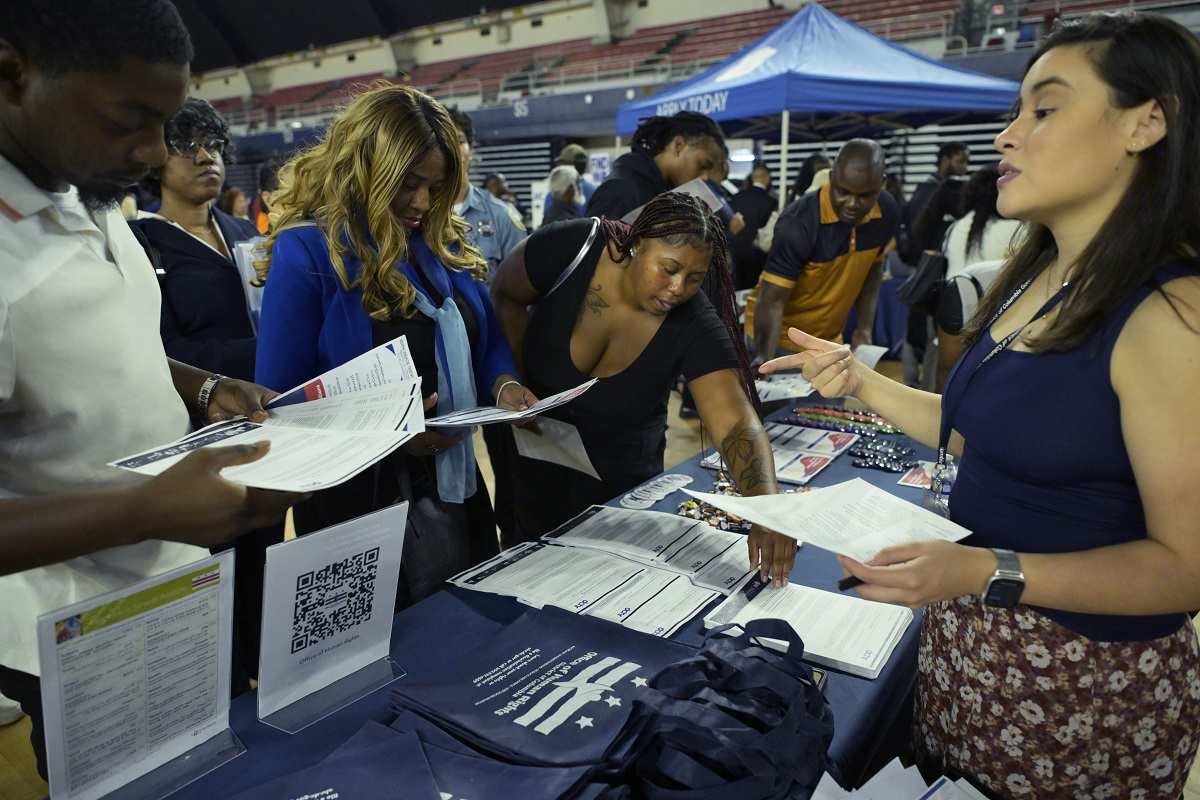Employers Added 254,000 Jobs in September, Reflecting Strong Gains as Election Nears

A job fair event on Sept. 20 in Washington, D.C.
16:40 JST, October 6, 2024
U.S. employers added 254,000 jobs and the unemployment rate ticked down to 4.1 percent in September, signaling strength in the labor market heading into the height of the election season.
The past several months of steady job growth have been plenty enough to keep the American labor market firmly out of recession territory, economists say, especially as GDP growth remains hardy, productivity is strong and consumers continue to spend.
In September, the service sector industry recorded a surge in hiring, according to the report by the Bureau of Labor Statistics. But job gains across most sectors added more evidence that the Federal Reserve can stay on track with gradual lowering of interest rates to ensure inflation doesn’t rear back up.
“The economy is amazingly strong going into November,” said Jason Furman, who chaired the Council of Economic Advisers under President Barack Obama. “This job growth is way above what anyone expected. The fears about unemployment have diminished and inflation keeps coming down.”
The impressive gains are welcome news for the Biden-Harris administration, which has spent months defending its record on the economy as Americans continue to feel the pinch of years of price gains that have eased but not dropped much. Policymakers say the strong data reflects the successful efforts of government spending on covid relief, manufacturing and the clean energy investments, while lowering inflation and maintaining a robust labor market for American workers.
“The pundits who said we couldn’t have low unemployment, growing wages and stable prices at the same time have been proven wrong,” said Kitty Richards, senior fellow at the Groundwork Collaborative, a left-leaning think tank, in an emailed note responding to Friday’s job gains.
Voters continue to favor former president Donald Trump over Harris on the economy, but his edge has declined considerably in recent weeks. Trump now averages a 6-percentage-point edge on the economy, compared with a 12-point lead against President Joe Biden earlier this year, according to an analysis of five polls that measured voters’ opinions before and after Biden dropped out of the race.
The jobs report became political fodder Friday, when Florida Republican Sen. Marco Rubio said on X that the strong jobs report was “fake,” without evidence. Trump allies have been accusing the Biden administration of manipulating jobs data for political gain. Biden responded directly to Rubio’s quip in remarks later Friday, saying at the White House: “anything MAGA Republicans don’t like, they call fake.”
Financial markets reacted with enthusiasm to September’s job gains, with all three major indexes jumping Friday morning, then retreating.
The unemployment rate in September fell for many demographic groups, including men and women. Joblessness among Black workers fell to 5.7 percent, retreating after a recent rise. The unemployment rate for Hispanic workers also fell, to 5.1 percent.
Wage growth in September was robust, growing by 0.4 percent over the month. Average hourly earnings have risen by 4 percent this year, to $35.36 an hour, outpacing the rate of inflation, resulting in a boost to workers’ pocketbooks.
Strong upward revisions to job gains in July and August data also suggest that the labor market is healthier than previously thought.
“This was a very encouraging payroll report, with job growth handily beating expectations,” Sonu Varghese, Global Macro Strategist at Carson Group said in an analyst note.
Still, some economists caution that the September report – known for carrying seasonal and technical noise as the summer ends and the school year begins – could be overstating the strength of the U.S. labor market, despite also showing real signs of robust expansion.
The report reflects a survey that the Bureau of Labor Statistics conducted before the Fed lowered interest rates last month. The data also does not reflect disruptions caused by Hurricane Helene, an ongoing labor strike at Boeing, and a brief but disruptive work stoppage at the East Coast and Gulf ports this week that ended Thursday. Those labor market changes will show up in the October jobs report scheduled for four days before the November presidential election.
The September job gains were spread across a variety of industries, sidestepping concerns that job growth in 2023 has been concentrated in a few key service-related sectors.
Food services and bars led payroll gains, rising by 69,000. That far exceeds the average monthly gain of 14,000 jobs over the past year, as Americans benefiting from wage gains have more disposable income to spend on going out. At the same time, these jobs tend to be lower-paying, less stable positions typically staffed by women and minorities.
Health care, fueled by the demands of an aging population, added 45,000 jobs, mostly in hospitals, nursing homes and home health care. Government added 31,000 jobs, primarily at the state and local levels. Social assistance, which includes services for individuals and families, added 27,000 jobs, while construction grew by 25,000 jobs, partly because of Biden administration spending on infrastructure and chips manufacturing.
Acting Labor Secretary Julie Su told The Washington Post that the “jobs report really crushed it.”
“It’s an economy that proves the wisdom of President Biden and Vice President Harris’s vision – that when you do right by workers, the economy is stronger,” she said.
Yet several industries continue to be weighed down by high interest rates. Employment levels in wholesale trade, financial services, and transportation and warehousing barely budged.
One major industry to lose jobs was manufacturing, partly because of weaker activity in that sector as well as retirements, regional hiring challenges, and skills shortages. The sector lost 7,000 jobs, which is significant because they tend to be higher-income opportunities for non-college-educated workers.
Weaker jobs reports and rising unemployment earlier this year partly played a role in prompting policymakers at the Federal Reserve to reduce interest rates by a half a percentage point for the first time since 2020.
That cut, which is lowering borrowing costs, is expected to bring relief to households and businesses eager to take out loans – and could lead to job gains in housing finance and residential construction. But it won’t immediately trigger a rebound in job creation, economists say, as sectors react differently to easing financial conditions. Industries weighed down by higher rates, such as professional and business services, information and manufacturing are expected to regain their vigor.
By historic measures, layoffs and the unemployment rate remain low. But the labor market is softer than it was in the period leading up to the pandemic. The rate of hiring is tied for the slowest pace in a decade, excluding the pandemic shutdown, according to a job openings report released Tuesday. Workers are quitting their jobs at the lowest rate since June 2020, according to data from that report.
Many economists have been watching to figure out whether the labor market slowdown is signaling a rebalancing of labor market dynamics or an impending recession.
“The inability of hiring to keep up with rising labor force participation has led to the rising unemployment we’ve seen since early 2023,” said Kevin Rinz, a senior fellow at the nonprofit Washington Center for Equitable Growth, in a written note. “It will be interesting to see how long the labor force will continue to grow in the face of slower hiring.”
"News Services" POPULAR ARTICLE
-

American Playwright Jeremy O. Harris Arrested in Japan on Alleged Drug Smuggling
-

Japan’s Nikkei Stock Average as JGB Yields, Yen Rise on Rate-Hike Bets
-

Japan’s Nikkei Stock Average Licks Wounds after Selloff Sparked by BOJ Hike Bets (UPDATE 1)
-

Japan’s Nikkei Stock Average Buoyed by Stable Yen; SoftBank’s Slide Caps Gains (UPDATE 1)
-

Japanese Bond Yields Zoom, Stocks Slide as Rate Hike Looms
JN ACCESS RANKING
-

Keidanren Chairman Yoshinobu Tsutsui Visits Kashiwazaki-Kariwa Nuclear Power Plant; Inspects New Emergency Safety System
-

Imports of Rare Earths from China Facing Delays, May Be Caused by Deterioration of Japan-China Relations
-

University of Tokyo Professor Discusses Japanese Economic Security in Interview Ahead of Forum
-

Japan Pulls out of Vietnam Nuclear Project, Complicating Hanoi’s Power Plans
-

Govt Aims to Expand NISA Program Lineup, Abolish Age Restriction



















